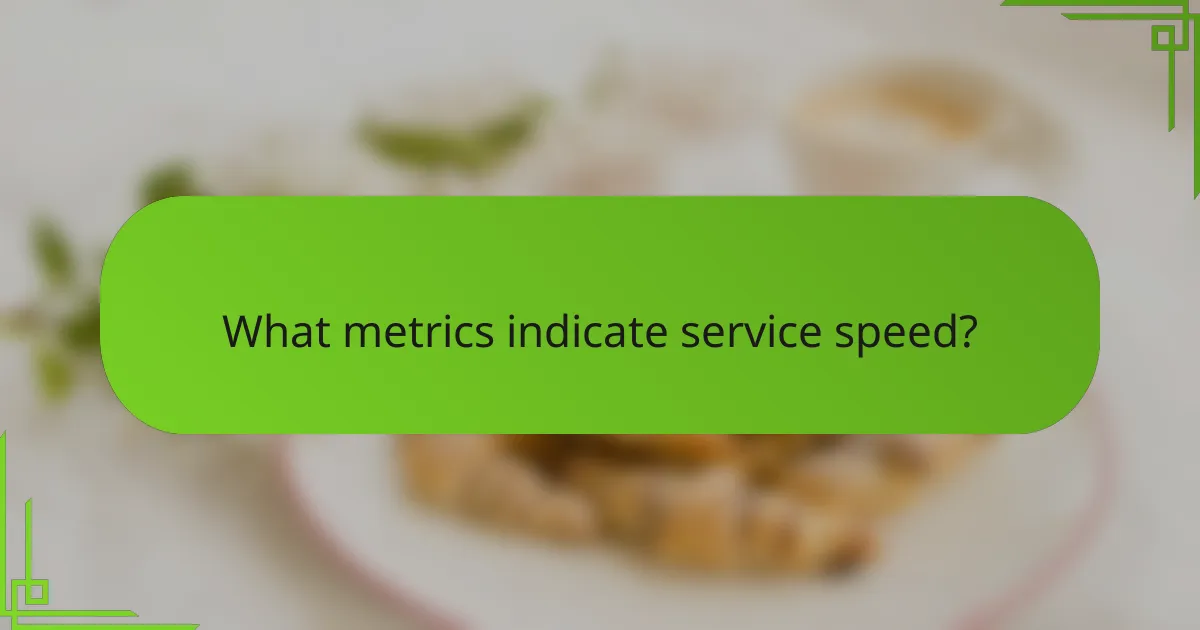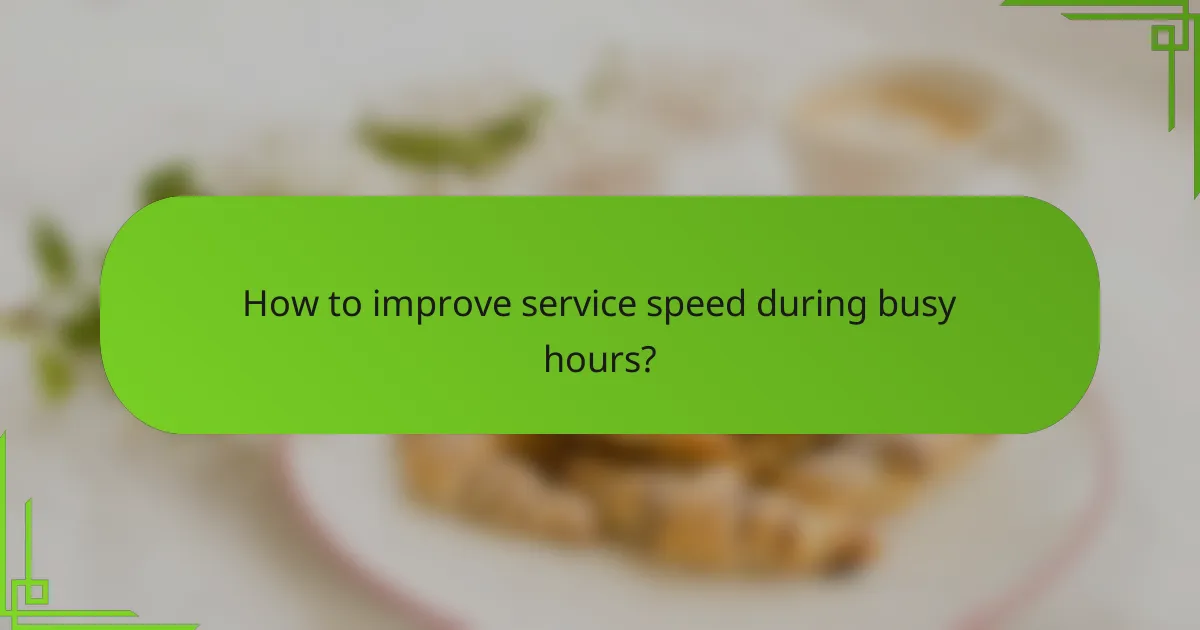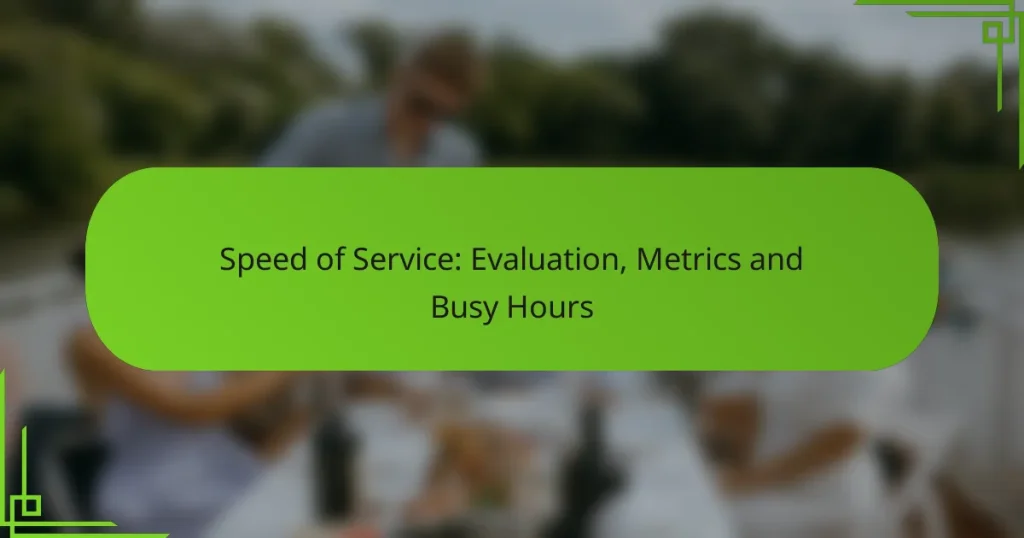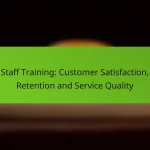Evaluating the speed of service in local businesses is crucial for enhancing customer satisfaction and operational efficiency. By measuring key metrics such as average response time and order fulfillment time, businesses can identify areas for improvement. Additionally, understanding peak busy hours allows for better staffing and service optimization, ensuring that customer needs are met promptly.

How to evaluate speed of service in local businesses?
Evaluating speed of service in local businesses involves measuring how quickly customers receive their orders and assistance. Key methods include gathering customer feedback, tracking service times, and comparing performance against industry benchmarks.
Customer feedback surveys
Customer feedback surveys are a direct way to assess perceived speed of service. By asking customers about their experiences, businesses can identify areas needing improvement. Surveys can be conducted online or in-person, and should include specific questions about wait times and overall satisfaction.
Consider using a mix of rating scales and open-ended questions to gather both quantitative and qualitative data. Aim for a response rate of at least 10-20% to ensure the feedback is representative of your customer base.
Service time tracking
Service time tracking involves recording the duration of various service interactions, from order placement to delivery. This data helps identify bottlenecks and peak service times, enabling businesses to optimize staffing and processes. Use tools like point-of-sale systems or manual logs to track these times accurately.
Establish a baseline for acceptable service times based on your industry. For example, a coffee shop may aim for a service time of under 5 minutes during busy hours, while a restaurant may target 10-15 minutes for food delivery.
Benchmarking against industry standards
Benchmarking against industry standards allows businesses to compare their service speed with competitors. Research typical service times in your sector to identify gaps and set realistic improvement goals. Industry reports and trade associations often provide valuable insights into these benchmarks.
For example, fast-food establishments typically aim for service times under 3 minutes, while full-service restaurants may target 15-20 minutes. Regularly review your performance against these standards to maintain competitiveness and enhance customer satisfaction.

What metrics indicate service speed?
Key metrics that indicate service speed include average response time, order fulfillment time, and customer wait time. These metrics help businesses assess efficiency and identify areas for improvement in their service delivery.
Average response time
Average response time measures how quickly a service provider reacts to a customer inquiry or request. This metric is crucial for businesses, especially in sectors like customer support and online services, where promptness can significantly affect customer satisfaction.
To calculate average response time, sum the total response times for a set period and divide by the number of responses. A typical target for many industries is to keep this time within a few seconds to a couple of minutes, depending on the complexity of the service.
Order fulfillment time
Order fulfillment time tracks the duration from when a customer places an order until they receive it. This metric is vital for retail and e-commerce businesses, as it directly impacts customer experience and loyalty.
To optimize order fulfillment time, businesses should streamline their processes, from inventory management to shipping. Aiming for fulfillment times within a few hours to a couple of days can enhance customer satisfaction and repeat business.
Customer wait time
Customer wait time refers to the duration customers spend waiting for service, whether in line or on hold. Reducing wait times is essential for improving overall service speed and enhancing customer satisfaction.
Businesses can manage customer wait time by implementing efficient scheduling, staffing adequately during peak hours, and utilizing technology like queue management systems. Aiming for wait times of under five minutes is generally advisable to maintain a positive customer experience.

When are the busiest hours for local services?
The busiest hours for local services typically occur during peak times when demand is highest, often influenced by work schedules and consumer habits. Understanding these hours can help businesses optimize staffing and improve service efficiency.
Weekday peak hours
Weekday peak hours usually fall between 7 AM to 9 AM and 5 PM to 7 PM. During these times, many people are commuting to and from work, leading to increased demand for services such as public transport, restaurants, and retail. Businesses should prepare for higher traffic and consider adjusting staffing levels accordingly.
To manage the influx, consider implementing strategies like online reservations or pre-ordering options, which can help streamline service during these busy periods.
Weekend service trends
On weekends, peak service hours often shift to late mornings and early afternoons, typically from 11 AM to 2 PM. Many consumers take advantage of their free time to shop, dine out, or engage in leisure activities, resulting in a surge in demand. Businesses should anticipate this trend and plan for increased customer flow during these hours.
Offering special promotions or events during these peak times can attract more customers and enhance their experience, making it a win-win for both parties.
Seasonal fluctuations
Seasonal fluctuations can significantly impact busy hours for local services. For instance, holidays and summer months often see increased activity, with specific days like Black Friday or Christmas Eve being exceptionally busy. Businesses should analyze past trends to predict and prepare for these seasonal peaks.
Adjusting hours of operation and staffing levels in anticipation of these fluctuations can help maintain service quality and customer satisfaction during high-demand periods.

How to improve service speed during busy hours?
Improving service speed during busy hours involves optimizing staff performance, streamlining workflows, and leveraging technology. By focusing on these areas, businesses can enhance efficiency and customer satisfaction, even when demand peaks.
Staff training programs
Effective staff training programs are essential for improving service speed. Regular training sessions can equip employees with the skills needed to handle high-pressure situations and reduce errors. Consider implementing role-playing exercises to simulate busy hours, allowing staff to practice quick decision-making and efficient service delivery.
Additionally, cross-training employees in multiple roles can provide flexibility during peak times, ensuring that all areas of service are adequately staffed. This versatility helps maintain a smooth operation when demand surges.
Efficient workflow management
Efficient workflow management is crucial for speeding up service during busy hours. Analyzing and optimizing each step of the service process can identify bottlenecks that slow down operations. For instance, rearranging the layout of service areas can minimize movement and streamline tasks.
Implementing a clear system for task delegation can also enhance efficiency. Establishing priorities and assigning roles based on peak times ensures that staff can focus on their responsibilities without unnecessary interruptions.
Technology integration
Integrating technology can significantly improve service speed during busy hours. Point-of-sale systems that process transactions quickly can reduce wait times, while mobile ordering apps allow customers to place orders in advance, easing congestion in service areas.
Consider utilizing customer relationship management (CRM) tools to track customer preferences and streamline service. This data can help staff provide personalized experiences quickly, enhancing overall satisfaction during peak periods.

What are the common challenges in measuring service speed?
Measuring service speed often encounters challenges that can skew results and hinder performance improvement. Key issues include data collection difficulties and inconsistent service standards, both of which can lead to unreliable metrics and misinformed decisions.
Data collection issues
Data collection issues arise when the methods used to gather information on service speed are flawed or incomplete. For instance, relying solely on manual entry can introduce human error, while automated systems may miss critical interactions, leading to gaps in data.
To improve data accuracy, businesses should implement standardized tracking systems that capture all relevant metrics consistently. Utilizing point-of-sale systems or customer feedback tools can help gather comprehensive data on service times.
Inconsistent service standards
Inconsistent service standards can complicate the measurement of service speed, as different employees or locations may have varying expectations and practices. This variability can result in significant differences in service times, making it difficult to establish a reliable baseline.
To address this challenge, organizations should develop clear service protocols and conduct regular training sessions to ensure all staff understand and adhere to the same standards. Regular audits can also help identify discrepancies and promote accountability.


